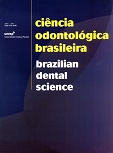Analysis of conventional and digital (digora) radiographic methods for
DOI:
https://doi.org/10.14295/bds.2003.v6i4.528Resumo
The purpose of this study was to test the hypothesis that the digital radiographic method (Digora), when comparedto the conventional radiographic method, allows better identification of the mineralized tissue barrier formed
after pulpotomy in dogs and protection of the remaining pulp with a resorbable membrane of demineralized
bovine cortical bone (Group I) and calcium hydroxide (Group II). Two dogs were used, according to the International
Organization for Standardization, specification #7405:1997: one for a follow-up period of 7 days and
another for the 70–day period. Ten teeth of each dog were submitted to pulpotomy, being 7 for Group I and 3 for
Group II, resulting in sixteen treated roots for each period. Standardized procedures were used to obtain and
analyze the conventional and digital radiographs. Radiographic images suggesting a mineralized barrier were
only distinguished in the roots treated with calcium hydroxide; however, no agreement was achieved between
four experienced observers. Concerning the comparison between the digital and conventional methods, a suggestive
image of a mineralized barrier was observed in four and five roots, respectively, but only one such root
belonged to the follow-up period of 70 days, when a dentin-like bridge was expected. In conclusion, the initial
hypothesis was not confirmed.
Downloads
Downloads
Publicado
Como Citar
Edição
Seção
Licença
TRANSFERÊNCIA DE DIREITOS AUTORAIS E DECLARAÇÃO DE RESPONSABILIDADE
Toda a propriedade de direitos autorais do artigo "____________________________________________________________________" é transferido do autor(es) para a CIÊNCIA ODONTOLÓGICA BRASILEIRA, no caso do trabalho ser publicado. O artigo não foi publicado em outro lugar e não foi submetido simultaneamente para publicação em outra revista.
Vimos por meio deste, atestar que trabalho é original e não apresenta dados manipulados, fraude ou plágio. Fizemos contribuição científica significativa para o estudo e estamos cientes dos dados apresentados e de acordo com a versão final do artigo. Assumimos total responsabilidade pelos aspectos éticos do estudo.
Este texto deve ser impresso e assinado por todos os autores. A versão digitalizada deverá ser apresentada como arquivo suplementar durante o processo de submissão.




























